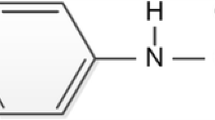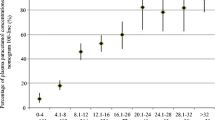Abstract
Background
Paracetamol overdoses cause severe liver damage; therefore, the German Drug Prescription Act was revised in 2009 to limit the over the counter availability of paracetamol in pharmacies to 10 g per pack without a medical prescription.
Objective
Data from two sources in northern Germany concerning paracetamol poisoning were evaluated. Special attention was paid to the change of prescription regulations and possible effects on paracetamol cases.
Material and methods
Data from the Department of Legal Medicine Hamburg (from 2007–2017) and the GIZ Nord Poison Center (from 2008–2017) were analyzed with respect to the development of case numbers over the time periods in question, poisoning severity, measured serum concentrations, patients’ medical history and factors, such as age, gender and cause of poisoning.
Results
No overall reduction in the number of paracetamol poisoning cases was noted in the Department of Legal Medicine Hamburg, even after the legislation change in 2009. The number of inquiries at the GIZ Nord Poison Center declined mostly for minor poisoning by 24% from 2010 to 2014. Severe poisoning remained nearly unchanged. Half of the patients in both collectives were younger than 21 years old. In adolescents and adult patients approximately 75% stated having overdosed on purpose. Young patients ingested the drug while unsupervised or were given wrong dosages by caregivers. Due to the short half-life of paracetamol, the analytical detection of paracetamol can be negative if blood is taken more than 15–18 h after ingestion.
Conclusion
The results show that paracetamol poisoning is still a major issue and the legislation changes did not have a relevant impact. It is necessary to further evaluate the possibility of stricter laws concerning availability of paracetamol.
Zusammenfassung
Hintergrund
Eine Überdosierung von Paracetamol verursacht schwere Leberschäden. Daher wurde die deutsche Verordnungspflicht im Jahr 2009 überarbeitet, um die freiverkäufliche Verfügbarkeit von Paracetamol in Apotheken auf 10 g pro Packung ohne ärztliche Verordnung zu begrenzen.
Ziel
Die Daten zweier Quellen in Norddeutschland bezüglich Vergiftungen durch Paracetamol wurden ausgewertet. Besonderes Augenmerk wurde auf die gesetzliche Änderung der Verschreibungspflicht und mögliche Auswirkungen auf Vergiftungsfälle durch Paracetamol gelegt.
Material und Methoden
Die Daten der Abteilung Rechtsmedizin Hamburg (von 2007–2017) sowie des Giftinformationszentrums Nord (GIZ-Nord; von 2008–2017) wurden hinsichtlich der Fallzahlenentwicklung in den betreffenden Zeiträumen, Schwere der Vergiftung, gemessenen Serumkonzentrationen, Krankengeschichte der Patienten sowie Faktoren, wie z. B. Alter, Geschlecht und Vergiftungsursache, analysiert.
Ergebnisse
In der Abteilung Rechtsmedizin Hamburg wurde kein Rückgang der Fallzahlen von Vergiftungen durch Paracetamol festgestellt, auch nicht nach der Gesetzesänderung im Jahr 2009. Die Anzahl der Anfragen beim GIZ-Nord bezüglich kleineren Vergiftungen gingen zwischen 2010 und 2014 um 24 % zurück. Schwere Vergiftungen blieben nahezu unverändert. Die Hälfte der Patienten in beiden Kollektiven waren jünger als 21 Jahre. Bei jugendlichen und erwachsenen Patienten gaben 75 % an, die Überdosis absichtlich genommen zu haben. Junge Patienten nahmen das Medikament unbeaufsichtigt ein oder bekamen von ihrem Betreuer die falsche Dosis verabreicht. Aufgrund der kurzen Halbwertszeit von Paracetamol kann das Ergebnis der analytischen Untersuchung von Paracetamol negativ ausfallen, wenn das Blut mehr als 15–18 h nach der Einnahme entnommen wurde.
Schlussfolgerung
Die Ergebnisse zeigen, dass eine Vergiftung durch Paracetamol noch immer ein großes Problem darstellt und die Gesetzesänderung keine relevanten Auswirkungen hatte. Eine weitere Ausschöpfung der Möglichkeiten einer strengeren Gesetzgebung bezüglich der Verfügbarkeit von Paracetamol ist notwendig.




Similar content being viewed by others
References
http://www.sueddeutsche.de/gesundheit/schmerzmittel-paracetamol-nur-noch-auf-rezept-1.1291725 (access: 30 Sept 2017)
Hawton K, Bergen H, Simkin S, Dodd S, Pocock P, Bernal W (2013) Long-term effect of reduced pack sizes of paracetamol on poisoning deaths and liver transplant activity in England and Wales: interrupted time series analyses. BMJ 346:403–411
Lee WM (2013) Acute liver failure. Semin Respir Crit Care Med 33:36–45
Canbay A, Tacke F, Hadem J, Trautwein C, Gerken G, Manns MP (2011) Acute liver failure—a life-threatening disease. Dtsch Arztebl Int 108(42):714–720
Von Mühlendahl KE, Oberdisse U, Bunjes R, Brockstedt M (2003) Vergiftungen im Kindesalter, 4th edn. Thieme, Stuttgart
Aktories K, Förstermann U, Hofmann FB, Starke K (2013) Allgemeine und spezielle Pharmakologie und Toxikologie, 11th edn. Elsevier, Munich
Schulz M, Iwersen-Bergmann S, Andresen H, Schmoldt A (2012) Therapeutic and toxic blood concentrations of nearly 1,000 drugs and other xenobiotics. Crit Care 16:R136
Darweesh SK, Ibrahim MF, El-Tahawy MA (2017) Effect of N‑Acetylcysteine on mortality and liver transplantation rate in non-acetaminophen-induced acute liver failure: a multicenter study. Clin Drug Investig 37:473–482
Appendix B to the Guidelines for quality assurance in forensic-toxicological analyses—Requirements for the validation of analytical methods. Authors: Peters F, Jena; Hartung M, Homburg/Saar; Herbold M, Schmitt G, Heidelberg; Daldrup T, Düsseldorf; Mußhoff F, Bonn; Version from 01.06.2009, in action since 01.04.2011, original German version published in Toxichem Krimtech 2009; 76 (3): 185–208
Schmitt G, Herbold M, Peters F (2011) VALISTAT—Software for method validation in Forensic Toxicology. Toxichem Krimtech 78:392–395
Persson HE, Sjöberg GK, Haines JA, Pronczuk de Garbino J (1998) Poisoning severity score grading of acute poisoning. Clin Toxicol 36:205–213
Pearce B, Grant IS (2008) Acute liver failure following therapeutic paracetamol administration in patients with muscular dystrophies. Anaesthesia 63:89–91
Ceelie I, James L, Gijsen V, Mathot R, Ito S, Tesselaar C, Tibboel D, Koren G, de Wildt S (2011) Acute liver failure after recommended doses of acetaminophen in patients with myopathies. Crit Care Med 39:678–682
Richter C, Andresen-Streichert H, Püschel K (2010) Vergiftungen mit Paracetamol bei Kindern und Jugendlichen. Päd Prakt Pädiatr 16:110–115
https://www.fsme.es/app/download/12277725424/Action-plan-MONSUE.pdf (access: 10 Oct 2018) MONSUE Project (Monitoring Suicidal Behaviour in Europe). Final Report on the Implementation of the Action (2007–2010)
Bundesinstitut für Risikobewertung (2009) Risiko Vergiftungsunfälle bei Kindern. BfR-Eigenverlag, Berlin, pp 6–7
Hein H, Püschel K, Schaper A, Iwersen-Bergmann S (2016) Akzidentielle Methadoneinnahme durch Kinder – Gedanken zur Verbesserung der Prävention. Arch Kriminol 237:38–46
Author information
Authors and Affiliations
Corresponding author
Ethics declarations
Conflict of interest
N. Aboutara, H. Jungen, A. Schaper, M. Sterneck, K. Püschel and S. Iwersen-Bergmann declare that they have no competing interests.
For this article no studies with human participants or animals were performed by any of the authors. All studies performed were in accordance with the ethical standards indicated in each case. Additional written informed consent was obtained from all individual participants or their legal representatives for whom identifying information is included in this article.
Rights and permissions
About this article
Cite this article
Aboutara, N., Jungen, H., Schaper, A. et al. Poisoning with paracetamol. Rechtsmedizin 29, 274–280 (2019). https://doi.org/10.1007/s00194-019-0332-4
Published:
Issue Date:
DOI: https://doi.org/10.1007/s00194-019-0332-4




